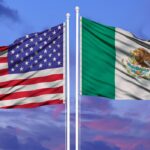Agronometrics in Charts: Mexican mango shipments to the U.S. expected to be 11% higher this season

In this installment of the ‘Agronometrics In Charts’ series, Sarah Ilyas studies the state of the Mexican mango season. Each week the series looks at a different horticultural commodity, focusing on a specific origin or topic visualizing the market factors that are driving change.
The arrival of mangos in Mexico can be traced back to the 16th century, when they were introduced by the Spaniards. The propitious climate of Mexico provided optimal conditions for the cultivation of mangos, leading to their sustained growth and proliferation.
As the years passed, Mexico emerged as a prominent hub for the production and exportation of mangos, boasting an extensive array of diverse varieties that have seamlessly integrated into the fabric of Mexican cuisine. “Mangos are the most popular fruit in the world,” says Tammy Wiard, retail manager for the National Mango Board (NMB) in Orlando, FL.
The U.S. Department of Agriculture reports 65% of U.S. mangos are imported from Mexico. The majority are Tommy Atkins, Kent, and Ataulfo varieties, according to the NMB.
The Mexican mango season began the first week of January and will run until the first week of October with a projection (up to week 40—10/7/2023) of approximately 101 million boxes. The season saw its peak in week 18, at 17.9 K tonnes, a 50% increase compared to week 18 of 2022.
“The last couple of years, May has seen a lower volume of mango overall. This year though the supply is strong and steady and the quality is great. We’re seeing a good May and we will have a good June and July as well,” says Rodrigo Diaz of Rio Rico, AZ-based Diazteca.
Favorable weather conditions in the mango- growing regions of Mexico created a conducive environment for abundant fruit production that has thus far demonstrated remarkable quality. Presently, the majority of mango supplies originate from Mexico, accompanied by supplementary volumes from Guatemala and the Dominican Republic while Peru concluded its season a few weeks ago.
According to the Mango Crop Report published by the National Mango Board, as of May 26, 3,063,402 boxes for a total of 36,551,408 boxes for the season were shipped by Mexico. (Michoacan: 26% - Sinaloa: 25% - Oaxaca: 18% - Chiapas: 11% - Nayarit: 17% - Guerrero and Jalisco: 3%). The 2023 Mexican season (up to week 40) is expected to be about 11% higher YOY (Year-On-Year).
 Source: USDA Market News via Agronometrics.
Source: USDA Market News via Agronometrics.
(Agronometrics users can view this chart with live updates here)
 Source: USDA Market News via Agronometrics.
Source: USDA Market News via Agronometrics.
(Agronometrics users can view this chart with live updates here)
Currently, there are large volumes of mangoes in the market which have caused prices to plunge. Week 21 saw the lowest prices so far, at $3.99 per package, a 33% fall compared to 2022.
 Source: USDA Market News via Agronometrics.
Source: USDA Market News via Agronometrics.
(Agronometrics users can view this chart with live updates here)
The Mexican mango industry is cognizant of the need to bolster and expand its international presence. The promotion of its MANGO EMEX seal of quality remains an important initiative among discerning international buyers.
Myrna Castro, the General Director of EMEX (Association of Producers - Exporters of Mangoes from Mexico), acknowledges the primary focus on the United States market while actively striving to enhance the global reach of Mexican mangoes. Emphasis is being placed on fortifying export activities to markets such as the European Union, Canada, and Japan. Furthermore, efforts are underway to forge robust export agreements with China and South Korea.
Carlos Palafox, producer and exporter of mangoes in Mexico, asserts that EMEX is actively championing the implementation of the seal of quality. This concerted effort aims to establish an organized framework, serving as a guide for continual improvement and meeting the expectations of the market.
The seal holds tremendous potential in terms of enhancing performance and ensuring the industry's enduring distinction. As a leader in the export sector, the industry is firmly committed to upholding and promoting the hallmark of quality that defines Mexican mangoes.
In our ‘In Charts’ series, we work to tell some of the stories that are moving the industry. Feel free to take a look at the other articles by clicking here.
All pricing for domestic US produce represents the spot market at Shipping Point (i.e. packing house/climate controlled warehouse, etc.). For imported fruit, the pricing data represents the spot market at Port of Entry.
You can keep track of the markets daily through Agronometrics, a data visualization tool built to help the industry make sense of the huge amounts of data that professionals need to access to make informed decisions. If you found the information and the charts from this article useful, feel free to visit us at www.agronometrics.com where you can easily access these same graphs, or explore the other 21 commodities we currently track.














































